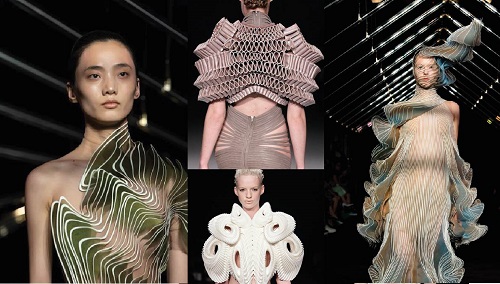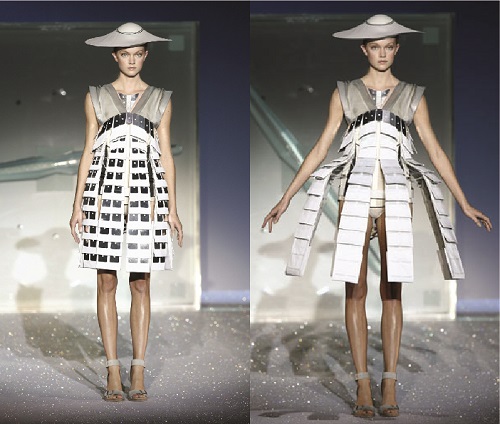Photo Courtesy: wired.com
As fashion evolves with integration of technology and design, 3d printing could be the next big thing in the industry because of the immense possibilities it offers to the designers.
3d printing is the process of joining materials under computer control to create a three dimensional object. This technology allows fashion designers to experiment beyond the traditional boundaries and create most extravagant designs.
Creating design elements by using the technique of 3d printing allows a designer to create intricate designs and advanced properties, such as waterproof, high flexibility and opaque effect. The beauty of it is that all these properties can be found on the same garment.
Advantages of 3D Printing
It helps in creating small intricate designs, shapes and forms that not only add on to visually pleasing aesthetics but also augments the functional purpose if it’s designed and engineered smartly.
• With 3d printing, functional properties, such as pockets and buttons can be made a part of the base fabric instead of it being a separate additional part.
• Customization can be taken to the next level as 3d printing has the ability to accurately create the right fit and curvature for each body part. This forms the perfect fit which many designers work hard to achieve. This will highly benefit in the field of sportswear for athletes when used with the right design.
Also, 3d printing provides numerous other possibilities that only can be tested through experiments with the technology.
Disadvantages of 3D Printing
Though 3d printing differs from substractive manufacturing that involves cutting away unwanted parts from large pieces of solid material and has helped in revolutionary developments in fashion, it has some disadvantages that are important to be considered before using the technology.
• Environmental Impact: 3d printing machines are hazardous and wasteful, and its environmental impacts have not been extensively studied. The energy consumption for each model making is higher than the traditional molding process; some studies show that it is approximately 50 to 100 times higher than the traditional manufacturing process.
• High Cost: The equipment and material used in 3d printing are very expensive. The machine itself costs very high, which highly increases the initial expenses of using the technology. For a single good quality machine, you would have to spend more than one or two lakhs. The material cost as compared to the traditional manufacturing is also higher.
• Limited Resources: 3d printers accept only certain materials for printing. This limits the options of using varied raw materials.
• Questionable Strength: In 3d printing, plastic is majorly used because it can be easily melted to create layers to form the product. So, the strength of the material is limited to that of a standard plastic.
• Not User Friendly: The machine requires one to have knowledge in using the technology and software skills for designing the product in 3d. This cannot be learned overnight as it requires training and practice before mastering it.
• Slow Process: 3d printing cannot be used in mass production, as it is time consuming. It takes several hours to complete small parts, which is not suitable for mass manufacturing.
Renowned Designers Employing 3D Printing
Iris Van Herpen

Photo courtesy: designboom.com, puloie.com, wired.com
The Dutch Designer, Iris Van Herpen is a futuristic designer who pushes the boundaries of what can be artistically presented in her designs using 3d printing. She is considered a pioneer in incorporating 3d printing in the fashion industry.
Her designs blend between the traditional and radical shapes to bring her sculptural and unique ideas to life. She hasn’t shied away from constantly innovating new possibilities by using the technology, with the help of experts.
Hussein Chalayan

Photo courtesy: edition.cnn.com
This British Designer is known for creating transformational dresses that are a result of architecture, design and technology. His sense of mixing architectural infused designs with transformation adds as a surprise element in the collection and has caught the attention of many. He has proved that fashion is not only about fabrics but also about incorporating advanced technology.
To conclude, we can say that 3d printing has been around for long time and has been experimented many times by many people. Now with 3d printing, designers are able to create flexible and durable designs than what we saw about 10 years ago. The awareness about this technology is growing slowly among designers but surely it’s going to be an integral part of the future of fashion.